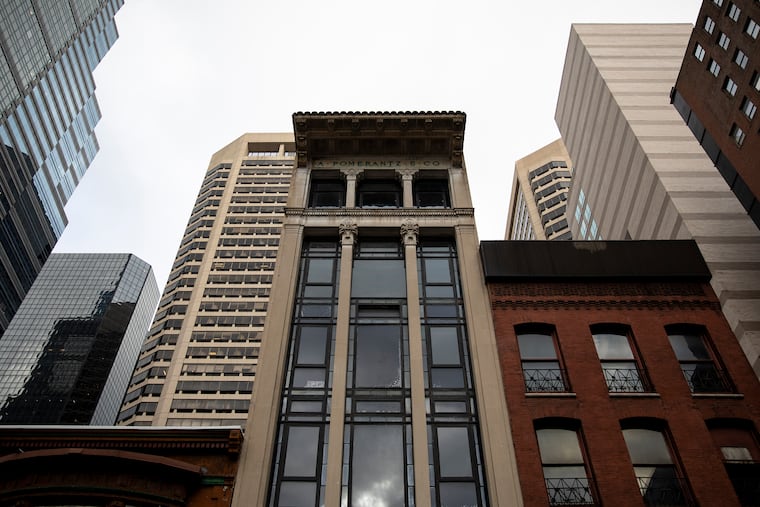Once Philly had an office supply district, and this was its premier supplier of pens, paper and pocket planners
Retail changes, but its architecture has many lives.

Because old habits are hard to break, this is the time of year when I set out in search of a pocket planner. I’m talking about the physical object, the slim book-like thing with paper grids displaying the days, weeks, and months of the coming year, and charts listing such “important facts” as appropriate birthday gemstones and wine vintages.
The area around Philadelphia’s City Hall was once dotted with stationery stores where you could peruse entire aisles stocked with planners in various sizes and formats, bound in buttery leather or vinyl snakeskin. But that was before our devices rendered whole categories of office supplies obsolete (Just Google Rolodex).
The most renowned of Center City’s stationery stores was A. Pomerantz & Co. at 1525 Chestnut St. The motto was “Everything for your office,” and it wasn’t kidding. The first two floors were stocked with pens, legal pads, spiral notebooks, staplers, tape dispensers, blotters, index cards, and the like. Above that were two floors devoted to office furniture, with a heavy emphasis on executive chairs. The company kept its own offices on the top two floors of the six-story building.
The Pomerantz store closed in 2007, done in by Staples, which continues to hang on across the street, although it is a shadow of its once bounteous self. A little over a decade later, the Pomerantz building is an architectural time capsule, largely unchanged above the ground floor. The company name is still spelled out in a dignified, almost dainty, serif typeface just below the monster cornice that shades the lower floors.
Like the pocket planners I favor, the facade is slim and trim. Built on a 22-foot-wide townhouse lot, it hovers 70 feet over Chestnut Street. When the company’s founder, Amen Pomerantz, commissioned the building in 1915, such a soaring structure would have been considered a skyscraper.
The architects, Simon & Bassett, initially planned to construct a steel structure, which would have further accentuated its verticality. But once the U.S. was drawn into World War I, steel became scarce, and the architects had to switch to reinforced concrete, according to the historical nomination, written by Jon Vimr and approved by the city in 2013. Because the frame carries so much weight, the side walls are 12 inches thick.
What gives the Pomerantz building its slender appearance is the skill of the architects. They conceived of the facade as a building-size classical column, with flutes rising, unbroken, up the surface. The intricately decorated cornice, which seems almost too big for such a diminutive structure, serves as the capital, topping off the column-building. The design also shows the influence of Louis Sullivan, who believed that skyscrapers should follow classical rules and have a base, middle, and crown (and who once worked for Frank Furness).
At the same time, the Pomerantz building has one foot in the modernist world. The limestone flutes are flat and largely undecorated. The windows are equally unfussy. Because it’s a concrete structure, Vimr observed, the facade is essentially “hung,” or pasted, on, much like today’s all-glass architecture. Completed in 1917, the year that Europe’s empires dissolved into nation states, Pomerantz is the embodiment of a world in profound transition.
Amen Pomerantz may not have been expecting such a style statement when he hired Simon & Bassett. A Russian Jew who arrived in America in the 1880s, he built up a thriving stationery trade by following Center City’s business district as it shifted west. After operating in several rented locations, Pomerantz believed a purpose-built store would help him stand out from other stationers clustered around Philadelphia’s new City Hall. The facade was part of the company’s branding, and Pomerantz used it repeatedly in advertisements. (Later, Simon & Bassett would become Simon & Simon, the firm that gave us the Strawbridge & Clothier building and the Rodeph Shalom synagogue on North Broad Street.)
The stationery store remained in the Pomerantz family until 1983, when it was purchased by the company’s vice president, Louis Applebaum (who later served as Philadelphia’s procurement commissioner). The downward slide began a few years later, after the company was acquired by investors. In 1994, the year Staples set up shop on Chestnut Street, the furniture side of the business was spun off as a separate company. It was bought, and continues to be run, by Garry Maddox, the superb centerfielder who helped the Phillies clinch the 1980 World Series. The stationery division, which was acquired by a group of Pomerantz employees, continued to operate the Chestnut Street store until 2007.
A variety of stores has inhabited the ground floor since then, but the upper floors remain empty. In 2012, it looked as if Pomerantz might have a second life as a boutique hotel, but the project never progressed. A new entity could have picked up the Pomerantz name or called it “The Stationers.”
Meanwhile, every year there are fewer places in Center City to buy a pocket planner. (Yes, I know you can order one online.) When I finally found the slim size that I like recently, the only color choices were blue and tan. I’m waiting for the day when these planners disappear completely from the area around City Hall. At least we will have Pomerantz to remind us of a time when stationery stores had an architecture all their own.
Note: This column has been updated to include information about the employee-run company that took over the Pomerantz stationery business after 1994.